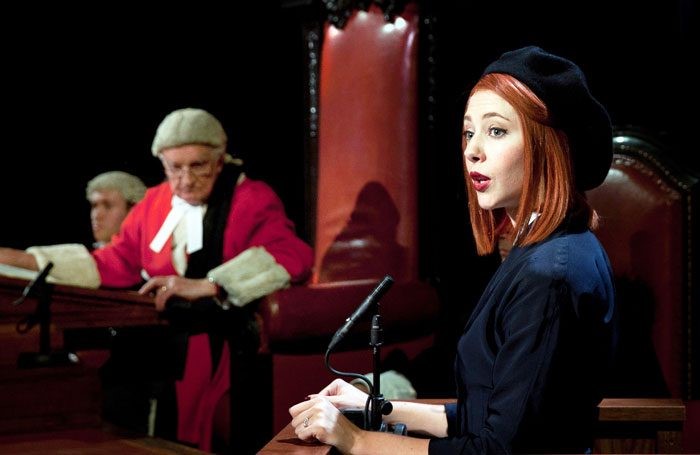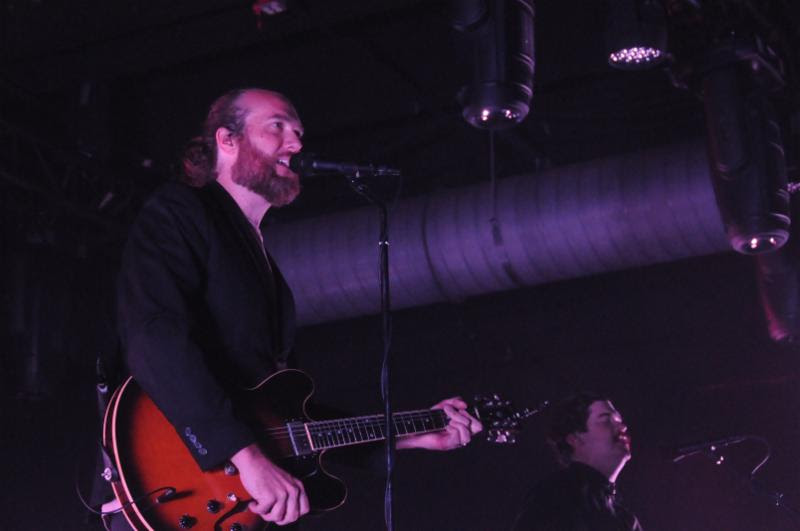Witness for the Prosecution, Christian Artist John Mark McMillan Selects DPA Microphones For Quality Audio
Story Highlights
DPA Microphones has been selected by Agatha Christies drama, Witness for the Prosecution, along with Christian artist John Mark McMillan for his three month on-the-road tour for clear and quality audio.
 Agatha Christie’s Courtroom Drama is Brought to Life by DPA
Agatha Christie’s Courtroom Drama is Brought to Life by DPA
Setting Agatha Christie’s classic play Witness for the Prosecution in the debating chamber of London’s County Hall proved quite a trial for the production’s sound crew, who had to cope with a variety of issues – not least a notoriously difficult acoustic environment. Yet, thanks to the judicious deployment of numerous loudspeakers and a selection of DPA Microphones, the challenges were overcome so well that the play opened to four- and five-star reviews and plenty of positive audience feedback.
Tony Award-winning sound designer Mic Pool, who is responsible for the system design, speech reinforcement and the content of the play’s soundscape, is using four DPA d:dicate 2011C Twin Diaphragm Cardioid Microphones as the fixed microphones for the judge, witness box and clerks. The actors are fitted with a total of 10 d:screet 4061 Miniature Microphones, which are hidden in their hair. The microphones and other sound equipment were supplied by Stage Sound Services – a company Pool often uses because they provide quality support and maximize what he can achieve within his budget.
“The DPA microphones contribute enormously to the success of the sound design for this production,” says Pool. “It is clear the audience is connecting with the performances and responding, moment by moment, and that is a positive indication that we have overcome the acoustics of the venue and created that vital aural connection between actor and audience on which the success of any play depends.”
Pool has been involved in theatre sound for over 40 years and has worked across the entire scale of theatrical activity, from productions in the West End and on Broadway, to regional, fringe and community companies. He was recommended as the sound designer for Witness for the Prosecution by the play’s director Lucy Bailey, with whom he has worked on six previous productions.
“Witness for the Prosecution is presented by Rebecca Stafford and Eleanor Lloyd. Stafford previously staged a different production in council chambers in Leeds and York,” explains Pool. “Stafford found the County Hall venue when she was looking for somewhere suitable for a London run. She joined forces with Lloyd, and together they developed and co-produced this production.”
With its 50-foot high marbled walls, the debating chamber at County Hall is visually magnificent, but this has resulted in an acoustic entirely unsuited to speech; as far back as 1922 there were letters and articles in the press bemoaning the poor audibility of debates. “We resolved to correct this, and our aim was to design a system that would allow every word to be heard,” says Pool. “We also wanted to enhance the audience experience and create the impression of a great acoustic to match the thrilling visual setting.”
The principal challenge was to drastically increase the ratio of direct to reverberant sound. Pool tackled this by designing a system that uses over 120 loudspeakers. “That equates to one speaker, no further than a metre away, for every three audience members, which had to be installed without making any alterations to the Grade II listed fabric and fittings of the building,” says Pool. “It was a very difficult and time-consuming job for our installation team led by production sound engineer Aidan Jones.”
Because the loudspeakers are close to the audience, the performance of the microphones is exposed in almost microscopic detail. “We set up a small area of audience seating with loudspeakers and associated processing and brought in two of the cast to experiment with many models of microphones as a test prior to putting the final spec out for quotation,” says Pool. “I had previously used d:dicate 2011Cs as float microphones for the vocal reinforcement of The 39 Steps on Broadway and had achieved great results. For this reason, I included them in our testing ‘shoot out.’ We were selecting for transparency and speech intelligibility and on that basis the 2011Cs were clearly superior to other tested models and were far more forgiving in off-axis use. An additional advantage was that they were visually extremely neutral, so much so that we decided to use them ‘as is’ rather than attempting to disguise them as the actual period microphones that would have been in use in court rooms in 1952 when our play is set.”
Pool adds that in this production the actors who play the lawyers are more mobile than they would be in a genuine court setting. “The 370 members of the audience are wrapped around the acting area, both at floor level and in three high galleries, so they need to move freely in order to play to all these seats.”
For them, and for all actors in other scenes, which are performed on a thrust stage in the center of the room, Pool is using d:screet 4061 Miniature Microphones in conjunction with wireless transmitters.
“I have used d:screet 4061s on most productions I’ve designed in recent years as they work well in a variety of positions on actors’ heads,” says Pool. “This is very important for this production because we are coping with hats and legal wigs, so we have to find positions that give good results for all these scenarios without resorting to excessive equalization. The closest members of our audience are less than a meter from the stage, so we bought the microphones in beige. They were expertly camouflaged using paint marker pens to precisely match hair and skin tones and patterning, by sound engineer Phoebe Jean Gosling so as to be practically invisible to the audience.
“We have eight areas where microphones are used. Each of these areas are fed, with individual time delay and level control, to 16 loudspeaker zones so that every audience member hears the live sound from the actor first. This means that the loudspeakers no longer appear to be the source of the reinforced sound – instead the audience believes they are listening directly to the actors’ voices from the position they are speaking from.”
To further enhance the clarity of the reinforced sound, the production is mixed line by line by sound operator Henry Harrod so that generally there is only one microphone live at any time.
Adapted from an Agatha Christie short story, Witness for the Prosecution details the trial of Leonard Vole – a man accused of murdering a widow to inherit her wealth. The original play premiered in London in 1953 and was described by Christie as ‘one of my plays that I like best myself.’ This particular version premiered in October and runs through March 2018.
Acclaimed Christian Singer/Songwriter John Mark McMillan Takes New Clear Sound on the Road to Support Latest Release
 John Mark McMillan is an artist and platinum-selling songwriter that bends genres and defies traditional musical categorization. When McMillan recently hit the road in support of his latest album, Mercury & Lightning, his long-time Front of House Engineer/Tour Manager (and brother) Chris McMillan relied on a selection of DPA Microphones to provide crystal clear, natural sound for the three-month tour.
John Mark McMillan is an artist and platinum-selling songwriter that bends genres and defies traditional musical categorization. When McMillan recently hit the road in support of his latest album, Mercury & Lightning, his long-time Front of House Engineer/Tour Manager (and brother) Chris McMillan relied on a selection of DPA Microphones to provide crystal clear, natural sound for the three-month tour.
McMillan was introduced to DPA at a megachurch in Charlotte. “The results were night and day,” says McMillan. “Everything sounded so natural, especially the drums. We weren’t fighting a lot with the drum bleed like we had in the past. I knew John Mark and the band would love them and knew we needed to have them.”
For the Mercury & Lightning Tour, McMillan added DPA’s d:facto 4018VL Linear Vocal Microphones and d:dicate 2011 Cardioid Microphone on guitar amps, bass amps, the snare drum and as a spot mic for acoustic segments, along with the d:vote 4099 Instrument Microphone on toms and outside kick drum
“The band instantly fell in love with the DPA microphones,” says McMillan. “John Mark is blown away by how great his vocals sound with the d:facto. He is not pushing by the end of the night because he is not overexerting himself trying to make up for something he is not hearing. Our drummer loves the 4099’s because we plug in and everything is just clearer, fuller and frequency-rich. In addition to the amazing sound we get using the d:vote 4099’s on the drums, the d:dicate 2011 does an incredible job on the guitars. The mics and amps are so smooth and the drum bleed is negligible. All of the DPA mics deliver such a big sound.”
McMillan has also used the d:dicate 2011 for some acoustic segments during the concert with great results. “House engineers immediately asked what we were doing because they couldn’t believe how natural the acoustic set came off,” he says. “The vocals and the guitar sounded like they were right in front of you, but you were really 50 feet back.”
McMillan also finds the engineering of DPA’s microphones to be second to none. “In the d:vote 4099, DPA has created an instrument microphone/mount combo for every situation. From strings to drums, it’s amazing how great they all sound. It’s also very cool seeing how you can just move the mic around and get a different sound. The d:vote 4099 is truly a one size fits all mic.”
When McMillan is not on tour with his artist brother, he handles the sound duties at his local church where he has also employed DPA mics. “After hearing the d:facto vocal mics, we ordered four of them the next day for the church,” says McMillan. “The improvements that the d:facto 4018 has made to the overall sound at the church is incredible. Tonally, everything is so rich. The vocals are so clear. We couldn’t be any happier with DPA and plan on using them going forward.”
